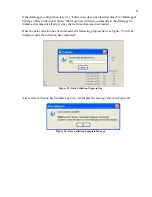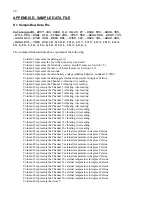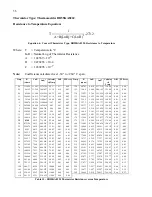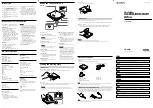
41
4. MAINTENANCE
While the Model LC-2x16 Datalogger is designed to operate in field environments, nevertheless
there are some basic maintenance procedures that should be followed to insure maximum
reliability and functionality.
4.1 Cleaning:
The outside of the box can be cleaned using a cloth dampened with soap and water.
DO NOT
USE ANY TYPES OF SOLVENTS OR SCOURING AGENTS!
The connector sockets can be cleaned using a small stiff brush (small painters brush) dipped in
soap and water. The sockets are water resistant so the internal electronics will not be adversely
affected by them filling with water or other liquids. Be aware however, readings could be
affected by shorting or other effects of an improper connection due to fluids being present in the
connector. Dry connections thoroughly before use.
4.2 Batteries:
When the unit is not in use, especially for extended periods of time, the 'D' cells should be
removed to prevent damage due to leakage.
The warranty does not cover damage due to
battery leakage.
The table below details the approximate operating times for the various types
of D-cell batteries which can be used with the Model LC-2x16.
Battery
Type
Battery
Capacity
4 Second
Scan Rate
1 Minute
Scan Rate
1 Hour
Scan Rate
1 Day
Scan Rate
Lithium
19 AHr
54 hours
128 days
1 year
4 years
Alkaline
14 AHr
20 hours
47 days
6 months
2 years
Carbon-Zinc
5 Ahr
6 hours
16.5 days
3 months
1 year
Table 9 - Approximate Operating Times
The above table assumes a constant temperature environment of 25°C (not field conditions!).
Battery life is shortened by temperature extremes. If the datalogger is continuously connected to
an active computers USB port, all operating power will be supplied via the USB port. As soon as
USB power is lost, the datalogger will immediately switch over to its internal 3V (or external
12V) battery pack.
Batteries should be replaced when the measured voltage drops below 1.8 VDC (internal 3V
battery) or 6V (external 12V battery). The datalogger electronics will stop the datalogger from
logging and disable RS-485 communications if the battery goes below 1.6 VDC (internal 3V
battery) or 5.5V (external 12V battery). In this event, a new set of batteries must be installed (or
USB connection must be made) before the datalogger becomes operable again. All data and
operating parameters are retained when removing batteries, even for an extended period (years)
of time due to non-volatile EEPROM memory. If the datalogger was logging when it stopped
itself due to low battery voltage, it will resume logging as soon as new batteries are installed or
as soon as it is connected to a USB port.
Содержание LC-2x16
Страница 2: ......
















































